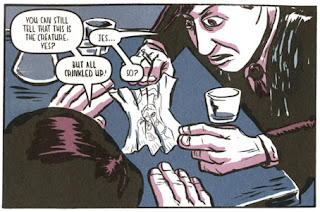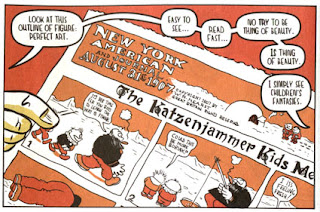
The Salon by Nick Bertozzi, 179 pages of strip, St Martin’s Griffin, 2007, US$19.95
There was quite a fad, a few years ago, for detective stories starring historical figures. People as diverse as Edward VII and Leonardo da Vinci were made to don their metaphorical deerstalkers. Some brave souls even pressed the likes of Jane Austen and Samuel Johnson into detective service, requiring the writers to tell first-person whodunnits in the ventriloquised voices of some of the finest and subtlest of English prose stylists. It was not a pretty sight.
Nick Bertozzi’s The Salon is a supernatural murder story involving the members of Gertrude Stein’s salon in 1907 Paris: her brother Leo, her lover Alice B Toklas, the poet and pornographer Guillaume Apollinaire, the composer Erik Satie and the painters Pablo Picasso and Georges Braque. Thankfully, the only attempt Bertozzi makes to mimic any of these artists is on the cover. Although the sinuous bulk of his figure work has traces of Gauguin, whose paintings feature heavily in the plot, it resembles Paul Pope rather more, so that is probably just coincidence.
The storytelling, though it deals with fantastic events, is linear and straightforwardly chronological, using a rigid four-panel grid on landscape-format pages. The artwork supports and supplements the story. For example, one of the motors of the plot is Leo Stein’s hatred for Alice B Toklas. To judge by her words and actions, this is under-motivated. But just look at the creepy face and body language Bertozzi gives her (she's the blonde woman, right of centre in this panel).

Would you want to share a house with those eyes?
The plot begins with the murders of several modernist painters, all apparently decapitated by a blue-skinned woman. This is linked to the use by the Steins’ circle of a special brand of absinthe that allows them to enter paintings – and, it later transpires, to allow the images in paintings to acquire real existence.

While these macabre events unfold, Braque and Picasso invent cubism. This is handled a little clumsily, in the manner of a Hollywood bio-pic, with “Eureka!” moments inspired by a picture of Braque in front of a mirror, or by a drawing crumpled up without thinking.

As in real life, according to most accounts, it is Braque who does all the thinking and most of the hard mental work, and Picasso whose grasp is instinctual and opportunistic.

Indeed, the whole story can be read as discussing the roots of creativity: native talent, the artificial inspiration of drugs, and rationality. At the climax of the story, the absinthe threatens to overwhelm everything, but is finally trumped by Picasso’s flamboyant, instinctive skill. That his efforts would have been impossible without the intellectual underpinnings provided by Braque is completely overlooked by most of the characters, but not by the reader. Indeed, it is impossible not to put down the book feeling a little sorry for Braque.
There are lots of incidental pleasures to reading The Salon. I liked the sequence in which Apollinaire assesses the pioneering photography of motion brought to him by Eadweard Muybridge for its value as pornography – in reality, it would be a significant source of inspiration to the cubists, because it showed a subject simultaneously at multiple points in time - rather like a comic strip does. And, indeed, Bertozzi shows us Picasso enthusing over the comics.

So perhaps the comic strip form of this book is not so far from the modernist painters’ intent after all, without requiring slavish imitation of technique.
Overall, this a cracking adventure story, with plenty to engage the brain too.
No comments:
Post a Comment